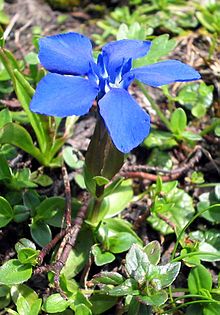Gentiana

Gentiana /ˌdʒɛntʃiˈeɪnə/[2] is a genus of flowering plants belonging to the gentian family (Gentianaceae), the tribe Gentianeae, and the monophyletic subtribe Gentianinae. With about 400 species it is considered a large genus. They are notable for their mostly large, trumpet-shaped flowers, which are often of an intense blue.[3]
The genus name is a tribute to Gentius, an Illyrian king who may have been the discoverer of tonic properties in gentians.[4]
This is a cosmopolitan genus, occurring in alpine habitats in temperate regions of Asia, Europe and the Americas. Some species also occur in northwestern Africa, eastern Australia, and New Zealand. They are annual, biennial, and perennial plants. Some are evergreen, others are not.
Many gentians are difficult to grow outside their wild habitat, but several species are available in cultivation. Gentians are fully hardy and can grow in full sun or partial shade. They grow in well-drained, neutral-to-acid soils rich in humus. They are popular in rock gardens.
Many beverages are made with gentian root.[5] Gentiana lutea is used to produce gentian, a distilled beverage produced in the Alps. Some species are harvested for the manufacture of apéritifs, liqueurs, and tonics.
Gentian root is a common beverage flavouring for bitters. The soft drink Moxie contains gentian root.[6] The Swiss apéritif Suze is made with gentian. Americano apéritifs contain gentian root for bitter flavoring.[7] It is an ingredient in the Italian liqueur Aperol. It is also used as the main flavor in the German after-dinner digestif called Underberg, and the main ingredient in Angostura bitters and Peychaud’s Bitters.
The bitter principle of gentian root is primarily gentiopicrin (also called gentiopicroside),[8] a glycoside. A 2007 paper by a Japanese group identified 23 compounds in fresh gentian root.[9] Gentiopicrin was absent from fresh root, so it possibly develops during drying and storage of the root.
